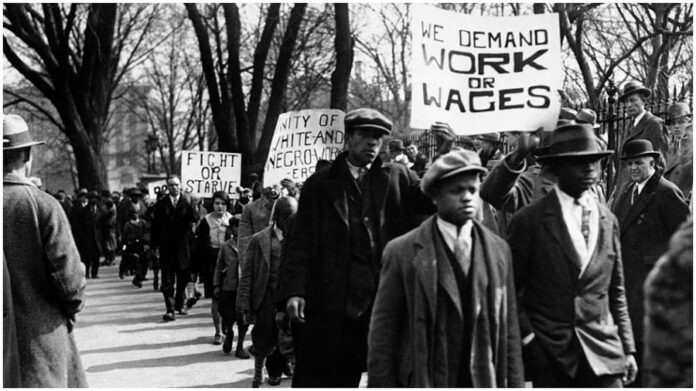The Great Depression created a palpable crisis throughout Australia. Gross Domestic Production declined by 10% between 1929 and 1931 and one in three people were unemployed by 1932.
Workers wages were slashed 10%. The Australian economy, heavily dependent on the export of primary products, saw world prices plummet by half. The government’s response was to invoke ‘The Premiers Plan’, which involved acquiescing to British bankers demands that Australian governments’ loans be repaid. The result was a cut in government expenditure of one fifth to repay capitalist bankers.
From 1929 the numbers of homeless people grew rapidly. Families were evicted onto the streets. People crowded in with relatives. Those with nowhere to go set up camps on the outskirts of towns and cities like the Dudley Flats shantytown on Footscray Road in Melbourne.
The concept of the ‘welfare state’ did not exist, so workers’ families were forced to rely on charity, handouts and food coupons to survive. About 40,000 mainly young men were turned out across the country to look for work, jumping ‘rattlers’ (trains) from town to town. Many stayed alive by living off their wits. Around Australia these unemployed were illegally fingerprinted, imprisoned, searched, intimidated, moved on and beaten up by local police.
Women carried a tremendous burden as family survival depended on women’s skills. Many industries relied solely on cheaper female labour. Men worked for ‘sustenance’ on public works building projects when available and stood in queues for the dole and rations. Workers were prisoners of the poverty caused by a rotten capitalist economic system. The ruling class hardened its position, refusing to make concessions to alleviate the suffering.
Activists and radicals began to appear on street corners, demanding ‘work, not charity’, and proclaiming that in the newly formed USSR people did not go without the necessities of life.
The Unemployed Workers Movement (UWM) was established by Communist Party of Australia (CPA) members who played a key role in both Sydney and Melbourne. UWM took a class-based position and declared that all workers had common interests that could be protected and advanced by united action.
The UWM was a highly democratic grassroots organisation of the unemployed, and created many talented leaders. It initiated and participated in anti-eviction rallies, free speech fights and community self help projects. In 1931 the UWM numbered 31,000 and by 1934 this had doubled to 68,000.
As there was no unemployment payment when the depression hit, the UWM organised mass demonstrations to win dole payments by June 1930. The UWM spearheaded struggles against evictions with notable battles against police in most cities.
It engaged in a free speech campaign opposing a state law banning so called ‘subversive gatherings’ whereby the police were used to break-up unemployed meetings.
This struggle was at its fiercest in Brunswick, Melbourne, where many UWM members were subject to repeated baton charges and arrest by police. A demonstration on Sydney Road involving 10,000 unemployed was viciously attacked. But ultimately the campaign was successful, and the government backed off.
Those with wealth and privilege took concerted action to protect their position and used the police to bash the unemployed with batons in an attempt to chase them off the streets. UWM members were arrested, convicted and jailed.
Magistrates flouted the law to silence and imprison militants. As working class militancy increased the ruling class formed a secret organisation called the “New Guard’, funded by banks and insurance companies with the aim of opposing ‘Bolshevism’ and protecting the capitalist state from disorder.
It attacked the unemployed, workers’ pickets and CPA political meetings. The CPA set up a ‘defence guard’ to protect its meetings, and at one notable Sydney meeting the ‘Battle of Bankstown’ took place and the New Guard met its match.
As the depression hit, union leaders were afraid to wage a fightback against sackings and cuts to wages. The ALP fell apart and most unions were overwhelmed, many ceasing to function and only recovering in the late-1930s.
Inside the unions, the CPA set up the Militant Minority Movement (MMM) in 1928, taking a class position amongst rank and file unionists. From 1933, as work slowly picked up, the militants of the UWM gained key union positions on the shop floor and then state level positions in the Waterside Workers, Train, Tramways, the Federated Engine Drivers and Fireman’s Association, and Miners and Metals unions.
Indeed the CPA led MMM comprised 20% of unionists and by 1937 unions with CPA leadership were restoring wages and conditions lost in the Depression.
The militants of the 1930s brought in a new, efficient and aggressive brand of unionism with a solid base among rank and file workers under the auspices of revolutionary socialists in the CPA. This period of work, growth and gains is rich in examples for us today, as we stare down the barrel of the COVID-19 “new normal”.



